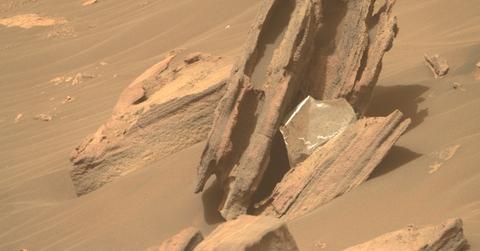NASA's Perseverance Rover Just Found Human Trash on Mars
Published June 21 2022, 3:57 p.m. ET
Not only are humans polluting Earth with litter, but apparently, our garbage is now making a mark on other planets. A NASA rover found trash on Mars recently, and it just goes to show how far and wide the impact of human trash can be.
This finding also brings up the matter of space junk, which is a serious issue in outer space. Keep reading for the details on the piece of trash found on Mars.
NASA’s Perseverance Mars Rover just found trash on Mars.
On June 15, 2022, the official Twitter account for NASA's Perseverance Mars Rover shared the news that a piece of trash had been found on Mars. The rover launched on July 30, 2020 and landed on Mars’ Jezero Crater on Feb. 18, 2021. Since then, it has been roaming the planet, looking for evidence of past life.
“My team has spotted something unexpected: It’s a piece of a thermal blanket that they think may have come from my descent stage, the rocket-powered jet pack that set me down on landing day back in 2021,” the account tweeted, alongside a photo of the object squeezed within a rock formation on the surface of Mars. (The Twitter account cheekily tweets from the voice of the rover itself.)
According to the Twitter account, though the debris looks like a shiny piece of foil, it is in fact part of a thermal blanket that was used on the outside of the rover to control temperatures.
NASA reported that the Mars Perseverance rover took photos of the debris using its Right Mastcam-Z camera on June 13.
Why was human trash found on Mars?
The Perseverance was supposed to be looking for signs of ancient life, but instead, wound up with a piece of rubbish.
“It’s a surprise finding this here,” the Perseverance Twitter account added, noting that the rover’s descent stage crashed about 2 kilometers (1.24 miles) away from this piece of blanket. “Did this piece land here after that, or was it blown here by the wind?” NASA wondered.
No matter exactly how the piece landed where it did, it is pretty concerning. Space exploration should be guided by the same principle that guides campers and hikers when they spend time in the great outdoors: leave no trace.
Hopefully this will motivate rover engineers to go to extra lengths to tightly secure all thermal blankets to their spacecrafts in the future. And although this particular space-littering instance was certainly an accident, leaving human-created junk behind is actually the norm in most instances of space exploration.
How much space junk is there?
Space junk, also known as orbital or space debris, is the name given to the approximately millions of pieces — totaling an estimated 6,000 tons — of broken, old, or used rockets, spaceships, satellites, power storage units, and other space tech that is currently orbiting the Earth in low Earth orbit (LEO). And the issue of space junk is no accident.
Astronauts commonly leave behind space tech such as batteries and power storage units behind on the moon or the planets they visit. Additionally after spaceships take off, their rocket boosters are literally meant to split off of the ship; if that happens after the spaceship enters orbit, they turn into space junk.
What’s interesting about the trash found on Mars in June of 2022 is not only that it was left there by accident, but that it has remained in place on the surface of Mars, as opposed to being carried into low Earth orbit like other space junk. The only thing stopping the piece of thermal blanket from entering LEO seems to be Mars’ rocky surface; as Space.com noted, the debris is wedged in between two rocks on the floor of Mars’ Jezero Crater.
